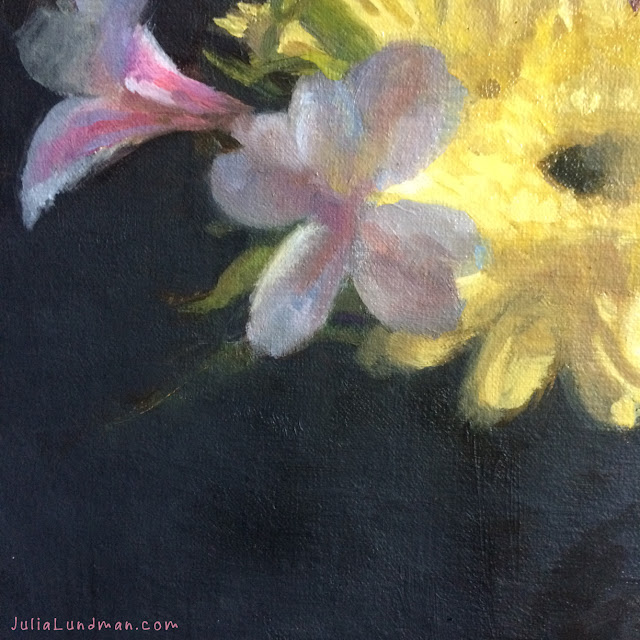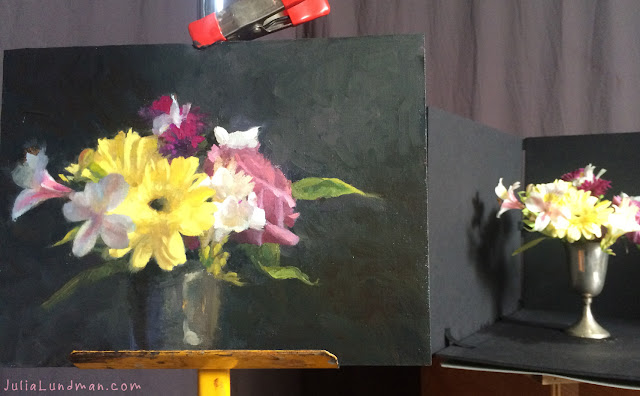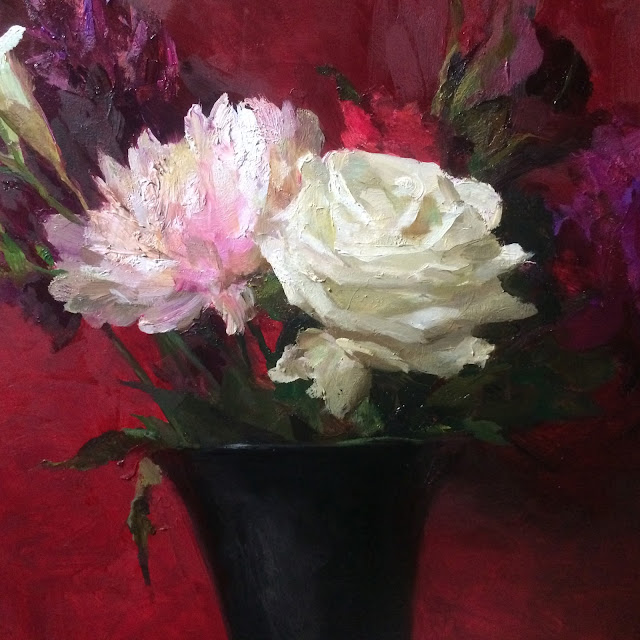"Every worthwhile art movement supports and encourages it's members to become better at what they do." - quote from Michael Klein.
This summer I have been very busy taking a Maya modeling class while I am also working on a personal project. Although most of the work I've been doing involves staring into my computer screen for most of the day, when I heard artist Michael Klein would be teaching a floral still life workshop at the Bay Area Classical Artist Atelier, otherwise known as BACCA, I jumped at the chance.
Here are just a few examples of Michael Klein's work, focusing on his florals. His work encompasses figures, still lives, and semi-narrative pieces, all done in a painting manner that brings the spirit of the subject to life with energetic, yet carefully planned brushwork. Much more of Klein's work can be seen on his website:
I love the textures and depth that he paints in his floral arrangements. They remind me a little of Fantin Latour florals while still being all his own.
Michael Klein's progress shot from his blog on his website. GORGEOUS!
********************************************************************
BACCA
The Bay Area Classic Artists Atelier is a wonderful traditional 19th century atelier right in the midst of an industrial park very near to Silicon Valley in San Carlos, California. The studio itself, run by tireless founder Linda Dulaney and a few dedicated studio hands, was comfortable to work in, providing taborets to store our supplies during the week, daily snacks, coffee, and relevant reading material on hand.
The atelier has a wide array of on-going workshops, courses and a once a week open studio with a model. During Michael Klein's floral painting workshop, next door in the adjoining studio, Dan Thompson was conducting a gross anatomy course with afternoon visits to Stanford's lab to study from a real specimen. I loved that there was a lot of great art on the walls that was not only Linda's, but also artists who have taught there, including great anatomy breakdowns on big sheets of butcher paper. Inspiring!
********************************************************************
WORKSHOP NOTES
Materials
Michael Klein provided us with an interesting palette of colors and arrangement I have not seen before now with lead white or titanium white in between his yellow and orange hues. Interestingly, he begins his arrangement with Viridian. Omitting Cadmium Red, he instead included Cadmium Orange. He also includes Ivory Black on his palette. Just past Ivory Black, low saturated colors sit towards the end of the palette arrangement with Raw and Burnt Umber. Colors are as follows in this arrangement:
Old Holland Viridian Green Deep
Michael Harding Raw Sienna
W and N Yellow Ochre Pale
W and N Cadmium Yellow Pale
Rublev Lead White no. 2
OH Cad. Orange
W and N Burnt Sienna
W and N Perm. Alizarin Crimson
OH Quincinadrone Magenta
W and N Cobalt Violet
W and N Cobalt Blue
OH Ultramarine Blue
OH Ivory Black
OH Raw Umber
OH Burnt Umber
Mediums used were simply Gamsol for cleaning brushes, which he uses mostly on the first day to thin down the paint a little if it's too thick or sticky. After day one, he uses a widely known mixture known as "fat medium", equal parts linseed oil plus damar varnish. In later stages of his paintings, he makes use of Rublev Oleogel to thicken up paint strokes and add texture. Paint rags were Viva paper towels.
I did not have Oleogel for the class, so Michael gave me a tiny smidgen to test out. The gel is used for glazing, but also for adding body and flow to the oil paint on top layers. It is truly amazing stuff. I ordered a big vat of it along with the lead white. Michael noted that with Lead White he will sometimes mix it with a few drops of walnut oil to loosen up the stiff mixture. (He also uses stack white from Rublev to create texture, although he wasn't using it in this workshop.)
Surface and Easel: Like many painters lately, Michael Klein paints on dibond, an inexpensive but very durable metal composite that is easy to order. It comes in one big sheet that arrives with a light primer on top, which he sands and then cuts into smaller pieces, after which he applies either gesso or lead gesso on top. Dibond sheets are easy to cut with a box cutter, which you can use to make scores and then break off into smaller sizes. Also, since the sheets are magnetic, they work really well with the magnetized holding mechanism of the Edge Pro pochade box, which he was using with a tripod. (I have one as well - it's very durable and sleek, although I can't recommend it for carrying around on long hikes because of the weight.)
Brushes: In our workshop, Michael Klein mostly used synthetic rounds. Rosemary and Company will be soon making a custom set of Michael Klein brushes which come with short handles and a pink rosey color he designed specifically for floral painting. I will definitely order a set!
Michael's custom brush set right under that tube of paint.
*****************************************************************
Process
Each of the four days of Michael Klein's workshop, he worked on a painting demo. He typically spends about 3-4 days working on a floral still life.
Mixed in with his natural flowers were two artificial flowers, which he doesn't like to use but did for this class. He noted that when flower companies make good quality artificial flowers, they mimic natural color patterns of the flower, like spray painting the joints of the stems and leaves with a little brownish overlay instead of one uniform green and will also boost saturation of petals. When using artificial flowers, you will need to understand the methods that manufacturers use to make their flowers appear real and compensate by using your observation and knowledge of real flowers. However, use real flowers whenever possible.

Michael's demo from the first day, pictured above. He explained that when it comes to floral paintings he usually spends the first day blocking in the first half, the second day the second half, third and fourth day for finishing and adjusting. Although he used to spend a lot of time making a detailed line drawing, which he then transferred to canvas, he no longer uses that method. These days he instead dives in with a block in of basic shapes, starting with the background area as a foil against the larger shapes and green leaves that typically sit underneath the main forms of the flowers. He sometimes uses a very soft fan brush to lightly brush over the background to knock down some edges and to avoid glare on the surface. He also noted that he tends to work from the center out, working on each shape one at a time.

My initial block in, above. Michael thought my background color was too far into the brown/warm tones so I worked on adjusting that the next day. I had been thinking I would warm up the cool ivory black background to be more warm, but he felt I should stick to the truth of what was in front of me because of the reflected light that worked into the flowers, especially the yellows.
On the second day, after watching more progress on Michael's demo, I made color adjustments to the background, after which I spent a lot of my time making drawing adjustments in order to get the shape relationships to balance a bit better. Unfortunately, it was then that I noticed I placed everything too far to the left of the canvas. Michael told me I could emphasize the atmosphere in the background to compensate. Using light as an element of composition is always a plus, in my book.
End of the second day I got most of the big areas in, adjusting drawing, color and value.
When I came in the on our third day, I was disappointed to find that almost the entire black background had sunk in, making the paint appear a dull lifeless black! Ugh! That might be ok in some situations, but in this case it really dulled out the color and made the flowers themselves look terrible. Michael explained to our class that sinking in happens when you paint over a dried layer of paint with no medium, which is why using some medium in subsequent layers is necessary. Sinking in can be fixed by either repainting or using spray touch varnish, which I couldn't use in this case because I would be painting all day and couldn't wait for the areas to dry. After some touching up and repainting, I realized I had lost the gesture and luminosity of the initial block in, which is so key to making florals feel fresh. A serious downer, but I pressed on. (incidentally, if I were at home working on this, it would be at this point I'd quit and start over)

You can see the sunken in areas especially in the black passages. The color here was completely painted over in order to correct the hues, but instead of remaining luminous, it flatted out and sunk into the canvas, creating a dullness. Yuk yuk yuk!!!
As for overpainting on a dry surface that already has oil paint, Michael explained that if you cut into paint with more turp (gamsol), the painting will crack, which is one reason, along with sinking in, that using a medium is necessary at this point. (In fact I have seen this happen in some of my own older floral paintings, a few of which I will not sell because of the cracking.) He likes to use linseed oil mixed with equal parts of damar varnish (a similar mixture "fat medium" that I've used in other classes). This along with Oleogel should be sufficient. It is OK to continue to clean brushes with gamsol, just as long as you don't cut the gamsol into your paint mixtures to thin down paint. (Don't panic if a few drops inevitably get in there, though!) A hard lesson to learn, but I will probably never forget...

After fixing what I could in the background, adding some light coming from the upper right, I pressed on, mainly working on the color relationships between the yellow flowers, and the white ones to the right.
Michael had an interesting side demo (below) on the paint effects that can be had by layering pigments. For instance, the neutral warm background color, when brushed or scrubbed into the surface, appears warm. When that very same color is lightly scumbled over the same, but thinner color, it appears to be cooler. How awesome is that? Also, he layered on thicker colors like a basic warm burnt sienna/ultramarine blue mixture that serves well for green shadows and then worked up to a floral orange hue to show the depth that can be created with these particular mixtures.

As for color mixing in general, he explained that he doesn't like to overmix his colors on the palette, but instead "loosely" mixes, keeping a bit of each original color separate, so that when the colors move on to the brush and then the painting, a light effect mixes them in our eyes, producing a color vibration. This is a technique I've seen before and used myself, especially with pastel paintings, and also have read about. Golden aged Illustrator Haddon Sundblom's painting method included using two pure colors on one brush to create a mixture directly on the canvas. I'm not sure if this method is an innovation by the Impressionists, but the idea of vibrating color via broken color and paint layers feels impressionist to me.
Also, regarding color mixing on the palette, Michael encouraged everyone to create a "puddle of color" that is essentially a color portrait of the thing you are painting, otherwise you will end up with a lot of muddled color. My own tendency to dance around the palette with all sorts of mixtures usually leads to confusion at times, which I need to work on correcting. He does not create "strings" of color on the palette, instead he creates the middle hue, shadow and light hues all in one puddle.

During his demo, he spoke a bit about using a combo of observation vs. knowledge of form. He explained that Jacob Collins emphasized a thorough understanding of form and how light moves across it, and it was when he finally understood what that meant, that he finally made some breakthroughs in his work. He went on to explain that after painting the initial gesture on the first day, he will start thinking about what he knows about how light reacts on the surface of particular forms. Often, he will not look at the still life but instead focus on the object being painted, paying attention to the direction of the light source and modeling the form so that it reads clearly while still maintaining the beauty of the still life.

This becomes particularly necessary when painting subjects like flowers, which change each day. When asked about his atelier training compared to how he paints now, he explained that in his current work, he is now concerned with evoking a mood or a feeling rather than rendering every bit of the subject in front of him, trying to find that balance between the truthful statement vs. gesture.
For form painting demos, Michael recommended the excellent form painting lessons by fellow Grand Central graduate, Scott Waddell. I've seen all of Scott's videos and they are indeed incredibly useful.
My final painting, which I've cropped to make a more attractive composition.
On the fourth and final day, Michael helped me at the end make some value relationship adjustments and talked with me about editing to the highlight, which did not serve the overall painting as it was too eye catching and distracted from the main subject. His emphasis throughout the workshop was always on the final, poetic statement rather than a 1:1 rendering of the subject, which I agree with wholeheartedly.
Michael Klein's finished four day demo.
During his demo on the fourth day, he spent some time working again on the main white rose, making shifts to it because it had opened more fully than it was a few days earlier. Rather than repainting it entirely or making too many drawing adjustments, he simply added to it, explaining that he liked that the new additions added more variety to the painting.
*****************************************************************
Is it Alla Prima?
I think over the years that the term Alla Prima has become overused and misunderstood. Alla Prima is strictly a one session painting. That session might last a full 12 hour day, sure, but it is always one session, wet into wet. This came up because I think, generally speaking, people tend to assume that any painting that has a looseness to it is an Alla Prima statement. I asked Michael if his paintings are not AP, what are they? His answer was simple, they are just paintings!
On a personal note, when I was first introduced to oil painting as an 18 year old art student at the American Academy of Art in Chicago and then at the Palette and Chisel where Richard Schmid and many other amazing artists were painting, I fell in love with what the medium could achieve and the promise of what I might be able to as well. I had never seen paint become so intriguing; sketchy, energetic brushwork that came together in harmony to represent everyday things like portraits and figures, still life, and animals with rich color and layers of texture. That is where I first heard the term Alla Prima, the painting approach that Richard Schmid popularized throughout the 80's and 90's and especially with the release of his book, Alla Prima.
1993, I think. I believe this was a four hour demo. I mainly remember being so stunned at how quickly he was able get down rich color juxtaposed against greys in the white objects - and especially how loose and sketchy it all was.
Of all those years, this unfortunately blurry photo along with the one above are all I took of the actual man. The majority of my photos taken were of actual works hanging on the walls in revolving shows, auctions or works in progress. I'm still kicking myself for taking these blurry photos!
As much as I love a good Alla Prima sketch, my question has always been the same, how can I maintain the look of an Alla Prima sketch but work on it for multiple days without losing that fresh brushwork? Often, when I worked on a painting more than one day, many of the problems I encountered in this workshop were similar - sinking in, dry cracking paint, or thick paint that just looked dull and lifeless, overworked, over rendered, boring. I've always admired painters that are able to maintain a fresh feel in their longer pieces, giving the impression that the work was painted quickly and effortlessly. It was a pleasure to finally meet Michael Klein and get to chat with him about various ways to strategize and plan a painting to create a mood, a visual poetry, throughout a longer, more elaborate work. What a great experience, one that I will keep close throughout my new paintings.
Note: My next several updates will be a switch back to digital work for a personal project I am working on. Entirely different, and yet so many of the core concepts overlap one another.
Thanks for reading!











































